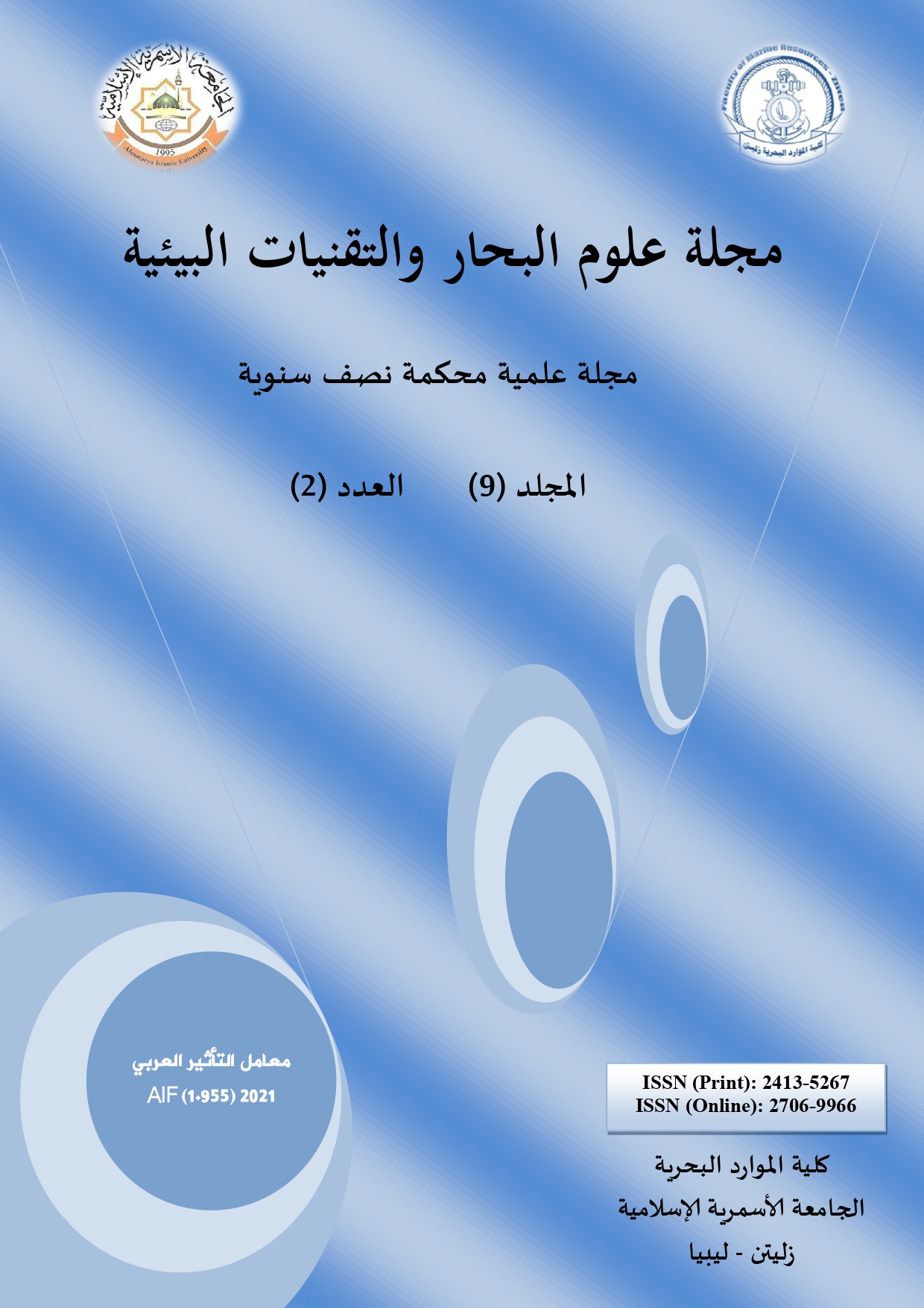تأثير وزن العامل على كفاءة العمل
DOI:
https://doi.org/10.59743/jmset.v9i2.160الكلمات المفتاحية:
الطاقة، الكفاءة، الوزنالملخص
أحد أهداف بيئة العمل هو تحقيق الأداء الفائق وحماية العمل أثناء بعض المهام البدنية مع تقليل الاضطرابات العضلية الهيكلية وإهدار الطاقة. في الآونة الأخيرة، كانت هناك مخاوف من أن قياسات الجسم قد تساهم ليس فقط في زيادة الاضطرابات العضلية الهيكلية ولكن أيضًا في تقليل طاقة الفرد وكفاءة العمل. ولذلك، كان الغرض من هذه الدراسة هو دراسة تأثير وزن الجسم على كفاءة العمل من حيث إنفاق طاقة النشاط (AEE). تم إجراء قياسات AEE باستخدام Actiheart على 12 وضعية منسقة للجذع والكتف أثناء مهمة الحفر. تم استخدام عينات مستقلة من اختبار t والاختلافات المتوسطة لتحليل آثار وزن الموضوع على AEE. أظهرت النتائج أن AEE انخفض مع زيادة وزن الشخص (الدهون الحرة) (R2 0.62). وأن الأفراد الذين يعانون من ارتفاع وزن الجسم (الدهون الحرة) يكلفون أقل من AEE وبالتالي يكونوا أكثر فعالية.
التنزيلات
المراجع
Brage, S., Brage, N., Franks, P., Ekelund, U., & Wareham, N. (2005). Reliability and validity of the combined heart rate and movement sensor Actiheart. European journal of clinical nutrition, 59(4), 561-570. DOI: https://doi.org/10.1038/sj.ejcn.1602118
Brage, S., Brage, N., Franks, P. W., Ekelund, U., Wong, M.-Y., Andersen, L. B., . . . Wareham, N. J. (2004). Branched equation modeling of simultaneous accelerometry and heart rate monitoring improves estimate of directly measured physical activity energy expenditure. Journal of applied physiology, 96(1), 343-351. DOI: https://doi.org/10.1152/japplphysiol.00703.2003
Bruso, J. (2017). The Average Lean Body Mass Livestrong.com. Retrieved 22 Agust, 2018, from https://www.livestrong.com/article/375603-what-is-a-good-bmi-for-women/
Bustillos, A. S., Vargas, K. G., & Gomero-Cuadra, R. (2015). Work productivity among adults with varied Body Mass Index: Results from a Canadian population-based survey. Journal of epidemiology and global health, 5(2), 191-199. DOI: https://doi.org/10.1016/j.jegh.2014.08.001
Eminoğlu, R. A. M. B., BEYAZ, R. A. A., & Okray, R. A. (2010). Comparison of tractor-rotary tiller combination and power tiller in terms of energy expenditure of operators. Paper presented at the XVIIth World Congress of the International Commission of Agricultural Engineering (CIGR), Québec. June (2010).
Garg, A., Chaffin, D. B., & Herrin, G. D. (1978). Prediction of metabolic rates for manual materials handling jobs. The American Industrial Hygiene Association Journal, 39(8), 661-674. DOI: https://doi.org/10.1080/0002889778507831
Goldsmith, R., Joanisse, D. R., Gallagher, D., Pavlovich, K., Shamoon, E., Leibel, R. L., & Rosenbaum, M. (2009). Effects of experimental weight perturbation on skeletal muscle work efficiency, fuel utilization, and biochemistry in human subjects. American Journal of Physiology-Regulatory, Integrative and Comparative Physiology, 298(1), R79-R88. DOI: https://doi.org/10.1152/ajpregu.00053.2009
Hellesvig-Gaskell. (2017). The effect of weight on heart rate. Retrieved 21 September, 2018, from https://www.livestrong.com/article/75211-effect-weight-heart-rate/
Hills, A. P., Mokhtar, N., & Byrne, N. M. (2014). Assessment of physical activity and energy expenditure: an overview of objective measures. Frontiers in nutrition, 1, 5. DOI: https://doi.org/10.3389/fnut.2014.00005
Hume, R. (1966). Prediction of lean body mass from height and weight. Journal of clinical pathology, 19(4), 389-391. DOI: https://doi.org/10.1136/jcp.19.4.389
Kahya, E. (2007). The effects of job characteristics and working conditions on job performance. International Journal of Industrial Ergonomics, 37(6), 515-523. DOI: https://doi.org/10.1016/j.ergon.2007.02.006
Kumari, S., Tewari, V., & Kumar, S. (2022). Assessment of physiological characteristics and effect of load on agricultural workers during push–pull operation under laboratory conditions. Materials Today: Proceedings, 66, 3748-3755. DOI: https://doi.org/10.1016/j.matpr.2022.06.007
Mathesan, K., & Mohan, A. (2015). Study and Analysis of Body Postures Using Ergonomic Assessment Tools in Drilling Operations. Journal of Industrial Safety Engineering, 2(1), 28-42.
Rasool, R., ur Rehman, A., & Khan, I. (2017). Assessment of health problems among pneumatic hand-held drill workers. Pakistan Journal of Health Sciences, 1(2), 60-64.
Sasikumar, R., & Lenin, K. (2017). Assessing the influence of hand-arm posture on mechanical responses of the human hand during drilling operation. The International Journal of Advanced Manufacturing Technology, 93(1-4), 375-384. DOI: https://doi.org/10.1007/s00170-016-9470-y
Shaik, A. R. (2015). Dental ergonomics: Basic steps to enhance work efficiency. Archives of Medicine and Health Sciences, 3(1), 138. DOI: https://doi.org/10.4103/2321-4848.154966
Shokshk, A. A., Ahmad, S. A., Aziz, F. A., Harith, H. H., Aziz, A. R. A., & Suliano, S. B. (2020). Effects of Non-neutral Posture and Anthropometry on Heart Rate in Hand Tools Tasks. Paper presented at the Advances in Material Sciences and Engineering, Singapore. DOI: https://doi.org/10.1007/978-981-13-8297-0_10
Shokshk, A. A., & Shokshok, M. A. (2021). Work Efficiency Model Based on Posture in Horizontal Drilling Task. Journal of Alasmarya University, 6(1), 1-12. DOI: https://doi.org/10.59743/aujas.v6i1.621
Singh, J., & Khan, A. A. (2012). Effects of position of the handles and feed force on discomfort score and grip strength during hand drilling. International Journal of Human Factors and Ergonomics, 1(2), 148-166. DOI: https://doi.org/10.1504/IJHFE.2012.048038
Strath, S. J., Brage, S., & Ekelund, U. (2005). Integration of physiological and accelerometer data to improve physical activity assessment. Medicine and science in sports and exercise, 37(11 Suppl), S563-571. DOI: https://doi.org/10.1249/01.mss.0000185650.68232.3f
Sylvia, L. G., Bernstein, E. E., Hubbard, J. L., Keating, L., & Anderson, E. J. (2014). A Practical Guide to Measuring Physical Activity. Journal of the Academy of Nutrition and Dietetics, 114(2), 199. DOI: https://doi.org/10.1016/j.jand.2013.09.018
Yu, N., Guo, J., Hong, L., Wu, P., & Li, J. (2018). Study on Fatigue of Workers in the Row Drilling Operation of Furniture Manufacturing Based on Operational Energy Efficiency Analysis. Paper presented at the International Conference on Man-Machine-Environment System Engineering. DOI: https://doi.org/10.1007/978-981-13-2481-9_8
التنزيلات
منشور
إصدار
القسم
الرخصة
الحقوق الفكرية (c) 2023 مجلة علوم البحار والتقنيات البيئية

هذا العمل مرخص بموجب Creative Commons Attribution 4.0 International License.












